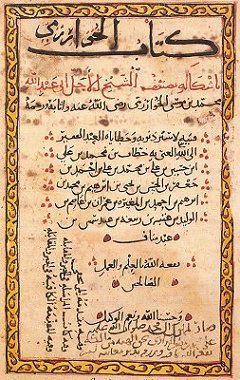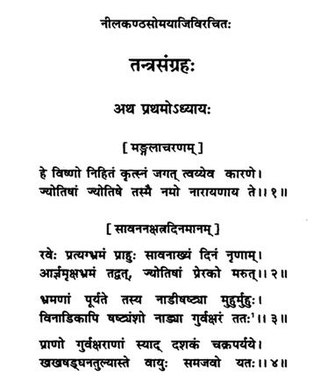Related Research Articles

Thiruvalla, alternately spelled Tiruvalla, is a town in Kerala and the Headquarters of the Taluk of the same name located in Pathanamthitta district in the State of Kerala, India. The town is spread over an area of 27.94 km2 (10.79 sq mi). It lies on the banks of the Pambas and Manimala rivers, and is a land-locked region surrounded by irrigating streams and rivers.It is the largest town in the district and central Travancore.

The history of science and technology in the Indian subcontinent begins with the prehistoric human activity of the Indus Valley Civilisation to the early Indian states and empires.
Indian mathematics emerged in the Indian subcontinent from 1200 BCE until the end of the 18th century. In the classical period of Indian mathematics, important contributions were made by scholars like Aryabhata, Brahmagupta, Bhaskara II, and Varāhamihira. The decimal number system in use today was first recorded in Indian mathematics. Indian mathematicians made early contributions to the study of the concept of zero as a number, negative numbers, arithmetic, and algebra. In addition, trigonometry was further advanced in India, and, in particular, the modern definitions of sine and cosine were developed there. These mathematical concepts were transmitted to the Middle East, China, and Europe and led to further developments that now form the foundations of many areas of mathematics.
Astronomy has long history in Indian subcontinent stretching from pre-historic to modern times. Some of the earliest roots of Indian astronomy can be dated to the period of Indus Valley civilisation or earlier. Astronomy later developed as a discipline of Vedanga, or one of the "auxiliary disciplines" associated with the study of the Vedas, dating 1500 BCE or older. The oldest known text is the Vedanga Jyotisha, dated to 1400–1200 BCE.
Mādhava of Sangamagrāma (Mādhavan) was an Indian mathematician and astronomer who is considered as the founder of the Kerala school of astronomy and mathematics. One of the greatest mathematician-astronomers of the Middle Ages, Madhava made pioneering contributions to the study of infinite series, calculus, trigonometry, geometry, and algebra. He was the first to use infinite series approximations for a range of trigonometric functions, which has been called the "decisive step onward from the finite procedures of ancient mathematics to treat their limit-passage to infinity".
Jyeṣṭhadeva was an astronomer-mathematician of the Kerala school of astronomy and mathematics founded by Madhava of Sangamagrama. He is best known as the author of Yuktibhāṣā, a commentary in Malayalam of Tantrasamgraha by Nilakantha Somayaji (1444–1544). In Yuktibhāṣā, Jyeṣṭhadeva had given complete proofs and rationale of the statements in Tantrasamgraha. This was unusual for traditional Indian mathematicians of the time. The Yuktibhāṣā is now believed to contain the essential elements of the calculus and one of the earliest treatise on the subject. Jyeṣṭhadeva also authored Drk-karana a treatise on astronomical observations.

The Kerala school of astronomy and mathematics or the Kerala school was a school of mathematics and astronomy founded by Madhava of Sangamagrama in Tirur, Malappuram, Kerala, India, which included among its members: Parameshvara, Neelakanta Somayaji, Jyeshtadeva, Achyuta Pisharati, Melpathur Narayana Bhattathiri and Achyuta Panikkar. The school flourished between the 14th and 16th centuries and its original discoveries seem to have ended with Narayana Bhattathiri (1559–1632). In attempting to solve astronomical problems, the Kerala school independently discovered a number of important mathematical concepts. Their most important results—series expansion for trigonometric functions—were described in Sanskrit verse in a book by Neelakanta called Tantrasangraha, and again in a commentary on this work, called Tantrasangraha-vakhya, of unknown authorship. The theorems were stated without proof, but proofs for the series for sine, cosine, and inverse tangent were provided a century later in the work Yuktibhasa, written in Malayalam, by Jyesthadeva, and also in a commentary on Tantrasangraha.

Mathematics during the Golden Age of Islam, especially during the 9th and 10th centuries, was built on Greek mathematics and Indian mathematics. Important progress was made, such as full development of the decimal place-value system to include decimal fractions, the first systematised study of algebra, and advances in geometry and trigonometry.

Yuktibhāṣā, also known as Gaṇita-yukti-bhāṣā and Gaṇitanyāyasaṅgraha, is a major treatise on mathematics and astronomy, written by the Indian astronomer Jyesthadeva of the Kerala school of mathematics around 1530. The treatise, written in Malayalam, is a consolidation of the discoveries by Madhava of Sangamagrama, Nilakantha Somayaji, Parameshvara, Jyeshtadeva, Achyuta Pisharati, and other astronomer-mathematicians of the Kerala school. It also exists in a Sanskrit version, with unclear author and date, composed as a rough translation of the Malayalam original.
David Edwin Pingree was an American historian of mathematics in the ancient world. He was a University Professor and Professor of History of Mathematics and Classics at Brown University.
Chitrabhanu was a mathematician of the Kerala school and a student of Nilakantha Somayaji. He was a Nambudiri brahmin from the town of Covvaram near present day Trissur. He is noted for a karaṇa, a concise astronomical manual, dated to 1530, an algebraic treatise, and a commentary on a poetic text. Nilakantha and he were both teachers of Shankara Variyar.

Tantrasamgraha, or Tantrasangraha, is an important astronomical treatise written by Nilakantha Somayaji, an astronomer/mathematician belonging to the Kerala school of astronomy and mathematics. The treatise was completed in 1501 CE. It consists of 432 verses in Sanskrit divided into eight chapters. Tantrasamgraha had spawned a few commentaries: Tantrasamgraha-vyakhya of anonymous authorship and Yuktibhāṣā authored by Jyeshtadeva in about 1550 CE. Tantrasangraha, together with its commentaries, bring forth the depths of the mathematical accomplishments the Kerala school of astronomy and mathematics, in particular the achievements of the remarkable mathematician of the school Sangamagrama Madhava. In his Tantrasangraha, Nilakantha revised Aryabhata's model for the planets Mercury and Venus. His equation of the centre for these planets remained the most accurate until the time of Johannes Kepler in the 17th century.
Charles Matthew Whish (1794–1833) was an English civil servant in the Madras Establishment of the East India Company. Whish was the first to bring to the notice of the western mathematical scholarship the achievements of the Kerala school of astronomy and mathematics. Whish wrote in his historical paper: Kerala mathematicians had ... laid the foundation for a complete system of fluxions ... and their works ... abound with fluxional forms and series to be found in no work of foreign countries. Whish was also a linguist and had prepared a grammar and a dictionary of the Malayalam language.
Shankara Variyar was an astronomer-mathematician of the Kerala school of astronomy and mathematics. His family were employed as temple-assistants in the temple at Tṛkkuṭaveli near modern Ottapalam.
Govinda Bhaṭṭathiri was an Indian astrologer and astronomer who flourished in Kerala during the thirteenth century CE.
In mathematics, Bhaskara I's sine approximation formula is a rational expression in one variable for the computation of the approximate values of the trigonometric sines discovered by Bhaskara I, a seventh-century Indian mathematician. This formula is given in his treatise titled Mahabhaskariya. It is not known how Bhaskara I arrived at his approximation formula. However, several historians of mathematics have put forward different hypotheses as to the method Bhaskara might have used to arrive at his formula. The formula is elegant, simple and enables one to compute reasonably accurate values of trigonometric sines without using any geometry whatsoever.
Kriyakramakari (Kriyā-kramakarī) is an elaborate commentary in Sanskrit written by Sankara Variar and Narayana, two astronomer-mathematicians belonging to the Kerala school of astronomy and mathematics, on Bhaskara II's well-known textbook on mathematics Lilavati. Kriyakramakari, along with Yuktibhasa of Jyeshthadeva, is one of the main sources of information about the work and contributions of Sangamagrama Madhava, the founder of Kerala school of astronomy and mathematics. Also the quotations given in this treatise throw much light on the contributions of several mathematicians and astronomers who had flourished in an earlier era. There are several quotations ascribed to Govindasvami a 9th-century astronomer from Kerala.

The Crest of the Peacock: Non-European Roots of Mathematicsis a book authored by George Gheverghese Joseph, and was first published by Princeton University Press in 1991. The book was brought out as a response to view of the history of mathematics epitomized by Morris Kline's statement that, comparing to what the Greeks achieved, "the mathematics of Egyptians and Babylonians is the scrawling of children just learning to write, as opposed to great literature", criticised by Joseph as "Eurocentric". The third edition of the book was released in 2011.
George Gheverghese Joseph, also known as G. G. Joseph is an Indian-born African mathematician who is a specialist in the history of mathematics. His works are mainly focused on the achievements of Kerala school of astronomy and mathematics and the transmission of mathematics from India to Europe.
Mathematics in India: 500 BCE–1800 CE is a monograph about the history of Indian mathematics. It was written by American historian of mathematics Kim Plofker, and published in 2009 by the Princeton University Press. The Basic Library List Committee of the Mathematical Association of America has classified the book as essential for undergraduate mathematics libraries, their highest rating.
References
- ↑ Joseph, George Gheverghese (2009). A Passage to Infinity : Medieval Indian Mathematics from Kerala and Its Impact. Delhi: Sage Publications (Inda) Pvt. Ltd. p. 236. ISBN 978-81-321-0168-0.
- ↑ Plofker, Kim (21 December 2015). "A Passage to Infinity: Medieval Indian Mathematics from Kerala and Its Impact". Aestimatio: Critical Reviews in the History of Science. 10: 56–62. doi: 10.33137/aestimatio.v10i0.26020 . ISSN 1549-4497.
- ↑ Sriram, M.S. (2011). "Book Review: A Passage to Infinity—Medieval Indian Mathematics and Its Impact". Indian Historical Review. 38 (2): 247–250. doi:10.1177/037698361103800207. ISSN 0376-9836. S2CID 149427309.